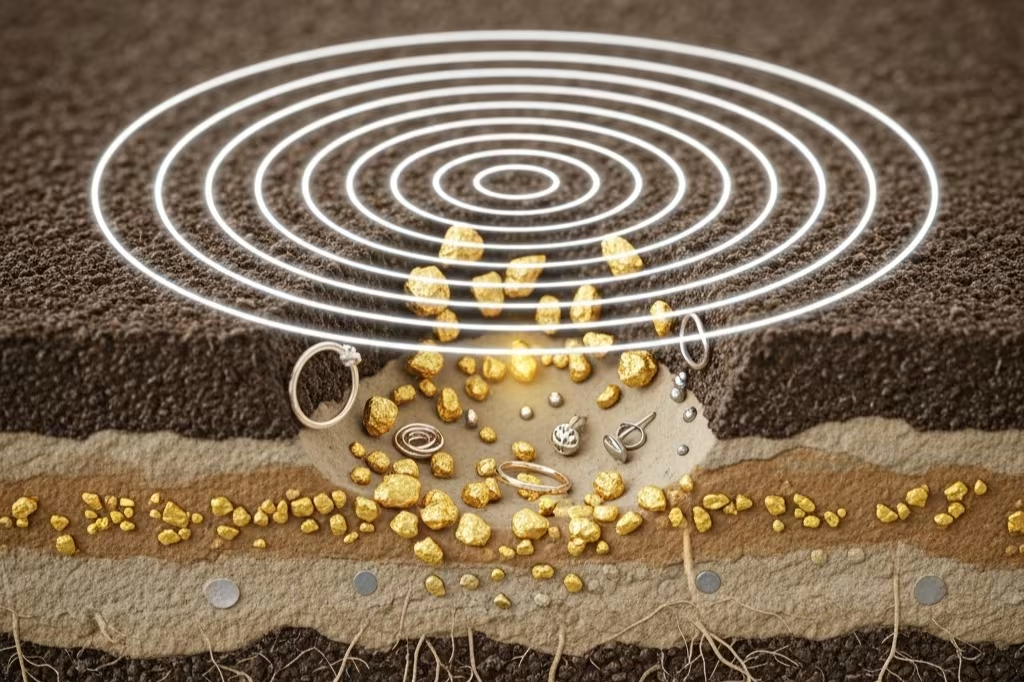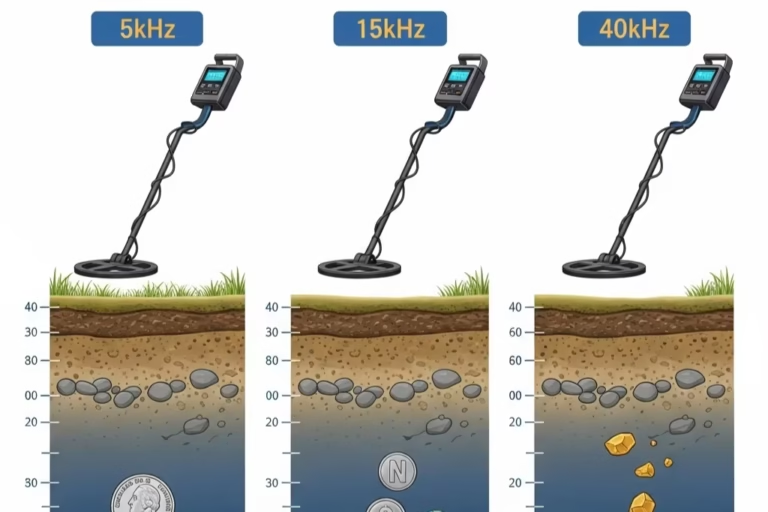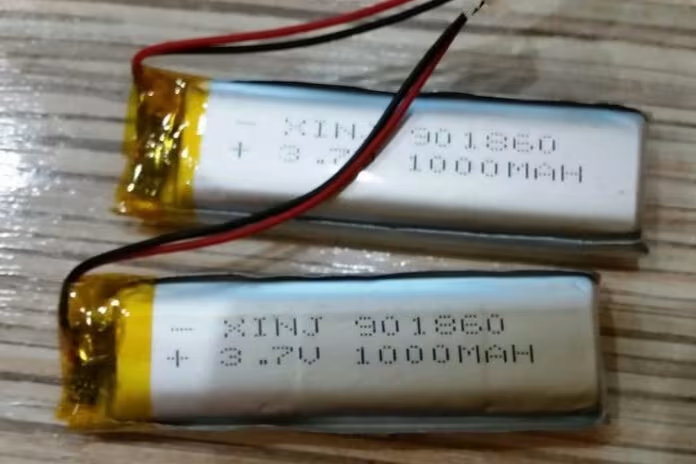When most people see a metal detector, they think “point and beep.” Me? I see a precision tool where picking the wrong frequency can mean walking over treasure without knowing it’s there.
Last week, my neighbor Tom knocked on my door with a huge grin. He held up a 1943 silver quarter. “Found it 14 inches down with my 5kHz setup,” he said, eyes practically glowing. Meanwhile, my buddy Chris had just scored his first gold ring using 40kHz at the beach. Same hobby. Totally different frequencies. Completely different results.
Sound familiar? If you’ve ever stood in a detector shop staring at frequency specs, wondering if 5kHz, 15kHz, or 40kHz will make you the next treasure hunting legend, you’re definitely not alone.
Here’s what I’ve learned after years of testing: picking the right metal detector frequency is hands down the most important decision for finding gold, coins, and relics.
- Why Metal Detector Frequency Choice Matters More Than You Think
- How Metal Detector Frequency Settings Actually Work
- 5kHz Metal Detector Frequency: Best for Deep Target Detection 💪
- 15kHz Metal Detector Frequency for Beginners: The Perfect Balance ⚖️
- 40kHz Metal Detector: Best Frequency for Gold Detecting 🏆
- Metal Detector Frequency Comparison: Performance Numbers 📊
- Choosing Metal Detector Frequency Settings: Your Action Plan 🎯
- Multi Frequency Metal Detector Benefits Revolution 🚀
- Avoid These Common Mistakes ⚠️
- Ground Truth: Soil Matters 🌍
- Your Next Move 🔥
- Metal Detector Frequency FAQ
- References
Why Metal Detector Frequency Choice Matters More Than You Think
Three years ago, I spent an entire Saturday at this amazing colonial site. I was using my shiny 40kHz detector, feeling pretty confident about my relic hunting skills. Found some tiny brass buttons – not bad, right?
Wrong.
The next weekend, Tom showed up with his “boring” 5kHz machine. In the exact same spot where I’d been hunting, he pulled up three large copper coins and a Spanish silver real. All of them were deeper than my high-tech detector could even dream of reaching.
Talk about a humbling experience! That’s when I realized something huge: frequency choice isn’t about personal preference. It’s pure strategy.
How Metal Detector Frequency Settings Actually Work
Think of it like this. Your detector sends electromagnetic waves underground thousands of times per second. That’s your frequency. Lower frequencies are like deep-sea submarines – they go way down but miss tiny stuff. Higher frequencies are like precision tweezers – perfect for small targets but can’t reach deep.
It’s basic physics, not marketing magic ^1^.
5kHz Metal Detector Frequency: Best for Deep Target Detection 💪

When you need to reach treasures that other hunters have walked over for decades, 5kHz is your secret weapon. This frequency absolutely crushes it for finding large, deep, valuable targets.
What 5kHz Metal Detector Frequency Finds Best for Coin Hunting:
- Big silver coins (quarters, halves, dollars)
- Heavy copper coins and tokens
- Large brass relics and military stuff
- Buried caches and containers
- Deep targets in nasty, mineralized soil
Where 5kHz Delivers Superior Metal Detector Penetration Depth
Old historical sites? Pure 5kHz territory. Those colonial homesteads and Civil War camps often hide their best treasures 12-18 inches down. That’s exactly where 5kHz reaches its sweet spot ^2^.
Tom’s collection proves this. He’s got more deep silver than anyone I know, and it’s all thanks to his 5kHz setup.
Tough, mineralized ground? No problem for 5kHz. I’ve hunted volcanic beaches where 40kHz detectors sound like angry bees. My 5kHz machine just hums along peacefully, finding deep targets in wet sand ^3^.
The 5kHz Metal Detector Frequency Limitations for Gold Detecting
Here’s what the 5kHz fans won’t tell you: it’s basically blind to small gold and thin jewelry. That delicate gold chain screaming on a 40kHz detector? Your 5kHz machine might not even notice it exists.
Small targets just don’t create enough electromagnetic response at low frequencies. Physics is unforgiving like that.
15kHz Metal Detector Frequency for Beginners: The Perfect Balance ⚖️
If 5kHz is a specialized deep-sea sub and 40kHz is a precision surface scanner, then 15kHz is like a great all-terrain vehicle. It does everything pretty well without being amazing at any one thing.
Why 15kHz Metal Detector Settings Work for Most Treasure Hunting
Most top-end detectors center around 15kHz. There’s a good reason for that. This frequency gives you decent depth for valuable finds while still catching medium and small targets ^4^.
What 15kHz Metal Detector Frequency Delivers:
- Quarter-sized silver coins down to 8-10 inches
- Gold wedding rings at reasonable depths
- Great target identification
- Stable performance in most soil
- Perfect for learning the ropes
Best Metal Detector Frequency for Park Hunting Success Story
Chris started his detecting journey with a 15kHz machine. Smart move. It forgives beginner mistakes while teaching proper technique. Park hunting involves crazy target variety – old coins, modern jewelry, small relics. 15kHz handles this mixed bag better than any other single frequency ^5^.
Last month at our club hunt, this played out perfectly. While Tom found his specialty deep silver and Maria scored tiny gold with her 40kHz setup, the 15kHz operators consistently filled their pouches with the most diverse finds.
40kHz Metal Detector: Best Frequency for Gold Detecting 🏆

When prospectors talk about finding “fly speck” gold – nuggets so small they look like black pepper – they’re talking 40kHz territory. This frequency is the absolute king of small target sensitivity.
What 40kHz High Frequency Metal Detecting Specializes In:
- Tiny gold nuggets (we’re talking sub-gram stuff)
- Delicate gold jewelry and thin chains
- Minute brass buttons and buckles
- Small lead artifacts and bullets
- Weird meteorite fragments
Where 40kHz Gold Nugget Detection Frequency Absolutely Shines
Gold prospecting? This is 40kHz’s home turf. In known gold areas, this frequency can spot 0.1-gram nuggets at 4-6 inches deep. Professional prospectors report finding 300-400% more small gold compared to lower frequencies ^6^.
Beach jewelry hunting? 40kHz is your best friend for finding lost rings and chains in the sand.
The 40kHz Metal Detector Challenges for Beginners (They’re Real)
Ground interference is brutal. Mineralized soil that barely bothers a 5kHz detector can make a 40kHz machine completely unusable. You need serious skills to handle challenging ground conditions ^7^.
Depth is limited. Large coins max out around 6-8 inches with 40kHz, compared to 12+ inches for 5kHz. The physics just don’t allow deep penetration at high frequencies.
Learning curve is steep. 40kHz detectors demand constant attention to ground balancing and sensitivity settings. Not beginner-friendly at all.
Metal Detector Frequency Comparison: Performance Numbers 📊
Real-world testing shows dramatic differences:
How Deep Can You Go? (Silver Quarter Test)
- 5kHz: 13 inches average
- 15kHz: 10 inches average
- 40kHz: 7 inches maximum
Small Gold Sensitivity (1-gram nugget)
- 5kHz: 4 inches max
- 15kHz: 6 inches average
- 40kHz: 8 inches – the clear winner
The bottom line: No single frequency does everything perfectly. Each one makes specific trade-offs ^8^.
Choosing Metal Detector Frequency Settings: Your Action Plan 🎯

Best Metal Detector Frequency for Beginners: Start Here
Go with 15kHz or a multi-frequency detector. You’ll learn fundamental skills without getting frustrated by limitations.
Best Frequency for Coin Shooting: Think Deep
Use 5kHz for deep silver, 15kHz for general coin hunting. Deep targets are where the real money hides in heavily hunted areas.
Best Metal Detector Frequency for Gold: Go High
40kHz is your best bet, but have backup options ready. Learn ground balancing first – you’ll need it.
Beach Metal Detecting Frequency: Stay Flexible
Multi-frequency detectors handle changing saltwater conditions best. Single frequencies struggle with beach challenges ^9^.
Multi Frequency Metal Detector Benefits Revolution 🚀
Modern detectors offer simultaneous multi-frequency operation. Think of it as combining 5kHz depth, 15kHz versatility, and 40kHz sensitivity all working together.
Testing confirms these detectors deliver on their promises for better target identification and ground handling ^10^. But they’re not magic – physics still rules.
Avoid These Common Mistakes ⚠️
Mistake #1: Deeper Must Be Better
Most valuable finds happen in the first 8 inches. Match your frequency to realistic expectations.
Mistake #2: Ignoring Local Soil
Regional ground conditions totally change frequency performance. Test in your actual hunting spots.
Mistake #3: Analysis Paralysis
Pick a frequency and start hunting. Field experience beats forum debates every time.
Ground Truth: Soil Matters 🌍
Soil conditions change everything. Highly mineralized ground loves low frequencies. Beach saltwater creates unique challenges where multi-frequency often wins.
Seasonal changes matter too. Spring deep coin hunting with 5kHz. Summer jewelry hunting with 40kHz. Adapt your strategy to conditions and targets.
Your Next Move 🔥
Understanding frequency transforms you from random beeper to strategic hunter. Take these insights to the field. Try different frequencies in your spots. Build your own experience database.
Remember Tom’s quarter from 14 inches down? That wasn’t luck. That was smart frequency choice plus understanding physics.
Key Frequency Insights:
- Learn your local soil with 100% certainty
- Start with 15kHz for balanced learning
- Test settings in actual hunting locations
- Master ground balancing before advanced frequencies
- Follow all local laws and ethics
The coolest part about frequency selection? Once you get the science, detecting transforms from random beeping to strategic treasure recovery.
Most people will keep using whatever frequency their detector came with. You? You’ll be the smart hunter who matches frequency to mission. Big difference.
Remember: Knowledge beats expensive gear every time. Master your frequency choice, and the finds will follow! 🏅
Metal Detector Frequency FAQ
Q: What’s the best frequency for someone just starting out? A: 15kHz is perfect for beginners. It teaches you the basics without overwhelming complexity. You’ll get decent depth and good sensitivity while learning proper technique.
Q: Why do gold hunters swear by 40kHz? A: Gold’s properties make it respond better to higher frequencies. Tiny nuggets that are invisible to lower frequencies light up like Christmas trees on 40kHz machines. It’s pure physics.
Q: Can 5kHz find gold effectively? A: Sure, for bigger gold pieces like heavy rings and chunky nuggets. But for small gold that makes up most natural finds? Not so much. It’s better for coins and relics.
Q: How does bad soil affect different frequencies? A: Mineralized ground creates interference that gets worse with higher frequencies. 5kHz stays stable where 40kHz goes crazy with false signals.
Q: Are multi-frequency detectors worth extra money? A: Absolutely. They eliminate the frequency guessing game by doing everything at once. Independent tests prove they deliver on performance promises.
Q: What frequency works best for old coins? A: 5kHz for deep silver coins, 15kHz for mixed coin hunting. Many serious hunters use both depending on site conditions and target expectations.
Q: Which frequency handles beach conditions best? A: Saltwater challenges favor multi-frequency or lower frequencies like 5kHz for stability. But 40kHz rocks for small jewelry in dry sand areas.
Q: How do I pick the right frequency for park hunting? A: 15kHz is your best bet for parks. It handles the crazy mix of coins, jewelry, and relics you’ll encounter. Great for beginners and pros alike.
References
- Nelson, C.V. (2004). Electromagnetic Target Discriminator Technology. Johns Hopkins APL Technical Digest, 25(4), 278-287.
- Minelab Electronics. (2023). Multi-IQ Technology White Paper. Retrieved from https://www.minelab.com
- Baker-Jarvis, J., et al. (2002). Measuring Permittivity and Permeability of Lossy Materials. NIST Technical Note 1514. Retrieved from https://www.nist.gov
- Garrett Metal Detectors. (2024). Multi-Flex Technology Documentation. Retrieved from https://www.garrett.com
- Fisher Research Labs. (2024). CZ-21 Dual Frequency Technology. Retrieved from https://www.fisherlab.com
- XP Metal Detectors. (2024). DEUS II FMF Technology. Retrieved from https://www.xpmetaldetectors.com
- MetalDetector.com. (2024). Metal Detector Frequency Guide. Retrieved from https://www.metaldetector.com/blogs/new_blog/metal-detector-frequency-guide
- UK Metal Detectors. (2024). Metal Detector Frequencies. Retrieved from https://www.uk-metal-detectors.co.uk/metal-detector-frequencies
- Gold Xtra. (2024). Understanding Metal Detector Frequencies. Retrieved from https://goldxtra.com/understanding-the-metal-detectors-frequencies/
- Society for American Archaeology. (2014). Task Force on Reality TV and Metal Detecting. Retrieved from https://www.saa.org

My name is Paul and I am the founder of Detector For Metal, a dedicated resource for metal detecting enthusiasts seeking to uncover historical treasures and connect with the past using the latest technology. As a stay-at-home dad and family man, I’ve found metal detecting to be the perfect hobby that combines family adventure with historical learnings for the whole family.
As a father, I’m deeply committed to passing on this hobby to the next generation of detectorists, starting with my own children. I share advice on everything from metal detecting with kids to exploring the top 10 metal detecting sites you never thought about. My methodical approach to the hobby goes beyond the thrill of discovery—it’s about creating family traditions while preserving history and sharing the stories of those who came before us.


